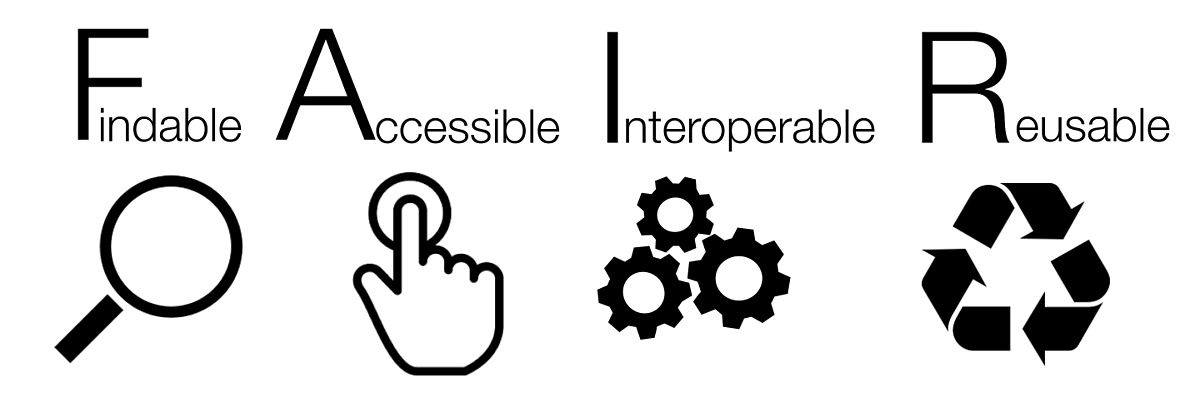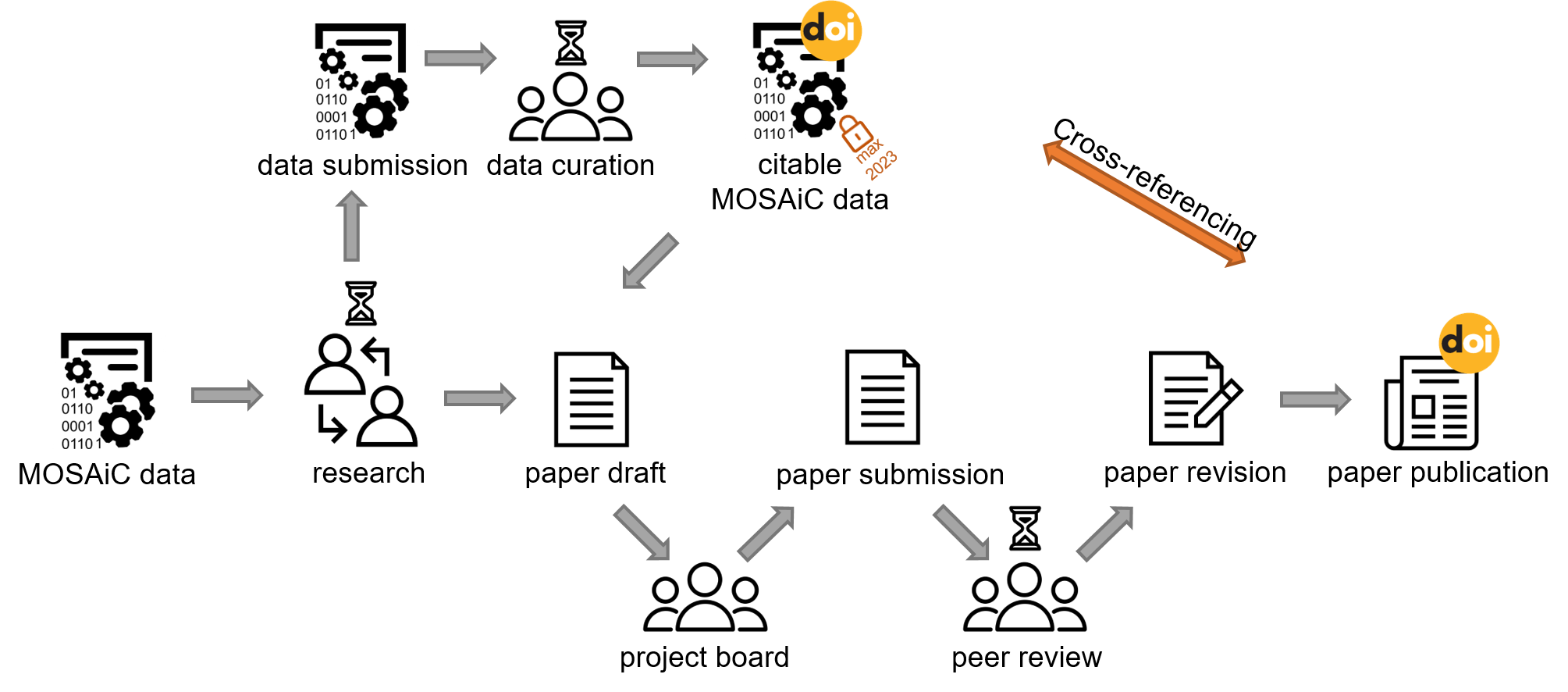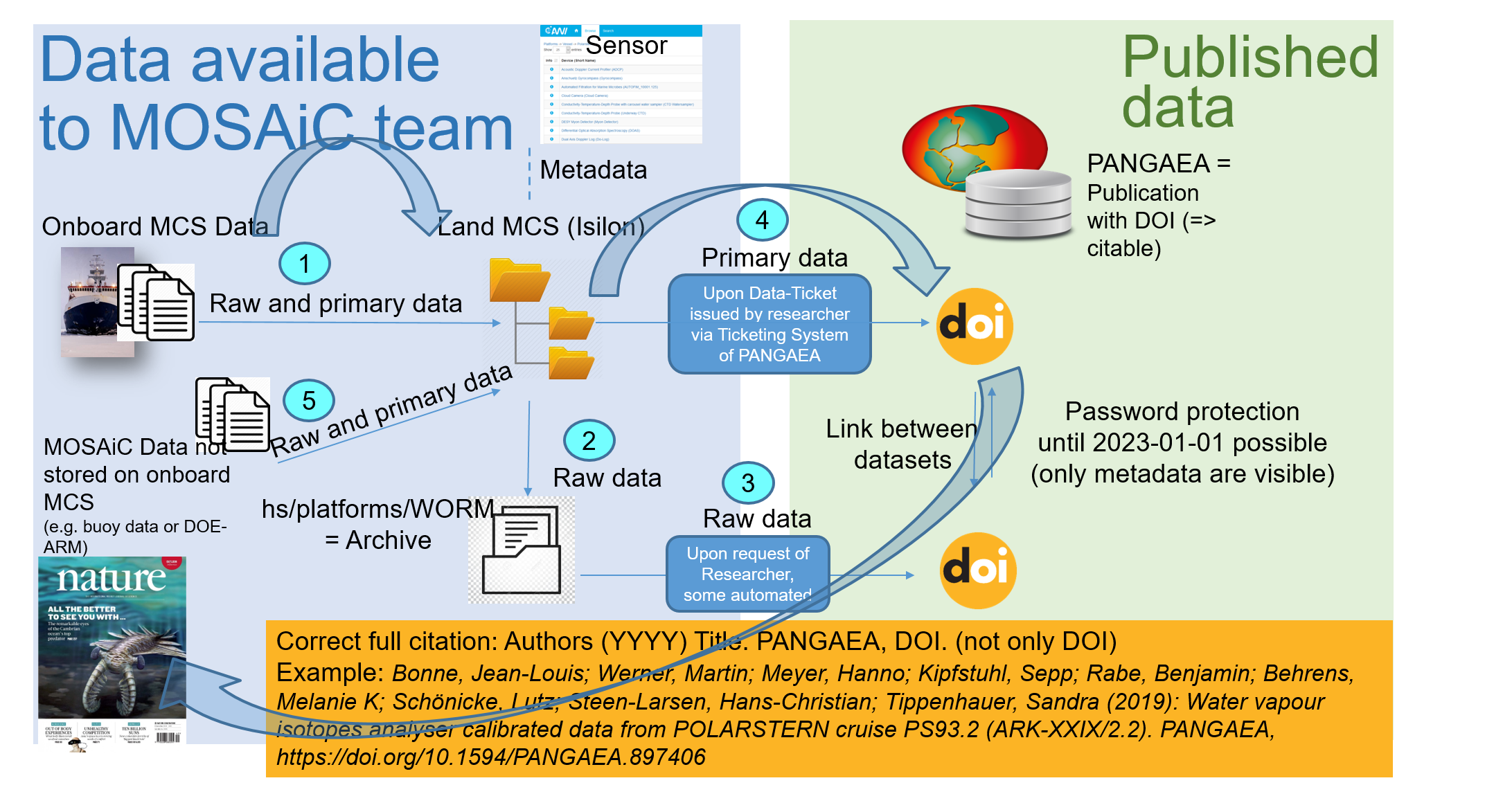- Created by Daniela Ransby, last modified on Nov 01, 2022
Why do I have to publish “my” MOSAiC data?
Fair data principles by SangyaPundir from Wikimedia Commons |
Resources
What is data publication?Why making a distinction between data publication and a manuscript?
What isn't data publication?
What is data publication?
How to cite a data set correctly?
|

A digital object identifier (DOI) is a persistent identifier used to identify objects uniquely
Metadata: Data about Data
- What? Parameter, unit
- Who? Author(s), PI, Institute(s), Articles
- Where? Latitude, longitude, depth in ice/snow/water/soil, altitude, elevation, distance along a profile, ...
- When? Date/time, age, ...
- How? method
Where do I publish “my” MOSAiC data?
|
Resources
- MOSAiC datasets collection at Marine Data Portal
- PANGAEA
- Arctic Data Center (ADC) data submission information and published data at DataONE portal
- Atmospheric Radiation Measurement (ARM) data center
- British Oceanographic Data Centre (BODC)
- UK Polar Data Centre
- Centre for Environmental Data Analysis (CEDA)
When do I submit and publish “my” MOSAiC data?
Data publishing workflow for primary (quality controlled) dataThe workflow drafted below includes publishing data sets in a data repository before the paper submission. Like that, the paper reviewers have access to the underlying data and can fully evaluate the conclusions of the study. This also enables correct cross-referencing of both data and manuscript.
group, peoples icon made by icon king from www.freeicons.io; password icon made by icon king from www.freeicons.io; document, content, article, letter, paper icon made by BECRIS from www.freeicons.io; |

A digital object identifier (DOI) is a persistent identifier used to identify objects uniquely
Resources
How do I approach data publication?Raw data / Primary data publication workflow
MOSAiC device operation ID / Event
Primary data submission to PANGAEAPublication of primary data sets in PANGAEA or other recommended repositories is the responsibility of each scientist (MOSAiC data policy). The data can be submitted via https://www.pangaea.de/submit/. Sign in with your user name. If you are not a PANGAEA user yet you need to register with your name and E-Mail address, or ideally your ORCID ID. This login can later also be used to access your password protected dataset during the review of your data publication. After signing up, you will receive a link via email to activate your account and sign in. Once logged in, click on “Submit data” and a data submission form will open. Metadata must be submitted together with the data. Minimal requirements are:
Finally you need to attach your dataset files. If your data files are larger than 100 MB we can provide an upload link for large files up to 10 GB per file. Please indicate this in the Description-field. Any documentation (e.g., MOSAiC Standard operating procedures, MSOPs) helping to understand the data can and should be linked to the dataset(s). This can be done in the form of text or pdf-file, or hdl (link to Epic). If no persistent link to the documents can be provided, PANGAEA can archive the documents permanently alongside the data. The granularity of the data is up to the author(s) of the dataset. Lower-granularity datasets can be combined in a (time-)series collection dataset as in https://doi.org/10.1594/PANGAEA.873032. During submission (https://www.pangaea.de/submit/), the connection with MOSAiC has to be clearly stated in the Label Field of the Data Submission ("MOSAiC"). The MOSAiC Project ID (for the Polarstern expedition this is "AWI_PS122_00") is internally associated as a grant number of the MOSAiC project and does not have to be inserted in the submission form additionally. Once all necessary information is entered and data files uploaded, the submission is finalized by pressing the “Create” button. Do not worry if you are uncertain about some fields or content, you will still be able to make final adjustments during the following steps and with support of your data curator. First the submission passes a brief editorial review to make sure the data submission is complete. If questions remain, we will get back to you. Then the submission will be assigned to a data curator who will lead you through the further process. After we’ve imported your data to PANGAEA, you’ll be asked to proofread your dataset, which is then “in review”. We lead you through this iterative process with our ticket system until the data submission is complete and approved by you. Once the dataset is approved, the digital object identifier, DOI, is registered and with that the dataset is officially published and citable. If the related manuscript has not been published yet, a moratorium on access and publication can be put in place. At the same time, PANGAEA can provide a temporary key to enable access to your datasets for example for anonymous reviewers. In general, moratorium on MOSAiC data is possible until 2023-01-01. If a published dataset needs to be updated, PANGAEA will upload a new version of this dataset, with new documentation and complete metadata (clearly providing information on the changes between the versions). Both versions can be linked but will have their own DOIs. Datasets in PANGAEA may be archived as stand-alone publications of data (e.g., https://doi.org/10.1594/PANGAEA.753658) or as supplements to an article (e.g., https://doi.org/10.1594/PANGAEA.846130). Data submission to PANGAEAWithin the data table, parameters (table header) should be submitted with full names and units. Data submitted in the form of videos, photos, geoTIFF, shape files, netCDF, sgy, etc. will be archived as is (e.g., https://doi.org/10.1594/PANGAEA.865445). More information on data submission can be found in https://wiki.pangaea.de/wiki/Data_submission. Preparing tabular data submission to PANGAEAData submitted as TAB-delimited text data files or in excel-format
Keep in mind when submitting in excel-format:
See also: https://wiki.pangaea.de/wiki/Data_submission for additional information Preparing binary files submission to PANGAEABinary files with specific formats (e.g. shape files, netCDF, segy, images, videos, ...) will be archived as links to files. For >20 files or >100 MB: ask us upload link in the ticket. Please prepare a file list including:
|
Resources
Good to know
MOSAiC Device operation ID (registered in D-ship Action log) = station Label (in SENSOR) = Event (in PANGAEA)
The list of MOSAiC Events can be found at https://pangaea.de/expeditions/byproject/MOSAiC.

ORCID: Open Researcher and Contributor ID is a nonproprietary alphanumeric code to uniquely identify scientific and other academic authors and contributors.
How do I share and publish my code/software related to the data?
|
Resources
- Arctic Data Center (ADC) data submission information
- zenodo.org
- No labels
- Powered by Atlassian Confluence 8.5.17
- Printed by Atlassian Confluence 8.5.17
- Report a bug
- Atlassian News


